This is an Edixa Reflex-C 35mm Single Lens Reflex camera made in West Germany by the Wirgin camera company. Wirgin had a line of 35mm rangefinder cameras also known as the Edixa, but this line of Edixa SLRs was in production under many different submodels from 1954 to around 1971. The Edixa line of SLRs was aimed at professional photographers as it supported a number of advanced features such as removable viewfinders, the M42 lens mount, had speeds as fast as 1/1000, and pioneered features such as instant return mirrors and selenium cell meters before many of their competitors. The line of Edixa SLRs continually improved, incorporating more and more new features as the years went on. They were generally well built cameras that sold well and represented a high point in the history of the Wirgin company.
Film Type: 135 (35mm)
Lens: 55mm f/1.8 Super Takumar + others
Lens Mount: Edixa M42 Screw Mount
Viewfinder: Interchangeable SLR Pentaprism
Shutter: Focal Plane Cloth
Speeds: B, 1 – 1/1000 seconds
Exposure Meter: Uncoupled Selenium Cell
Battery: None
Flash Mount: M and X Flash Sync
Weight: 941 grams, 786 grams (body only)
Manual (similar model): http://www.cameramanuals.org/pdf_files/edixa-reflex.pdf
My Final WordHow these ratings work |
The Wirgin Edixa Reflex SLR was a state of the art camera for it’s time that incorporated many firsts. It is a beautiful camera that is fun and easy to use. It has the best viewfinder of any camera that I’ve used from the era. It would take the rest of the world nearly two decades to release something with as bright and useful of a finder as on this camera. Although I do not have an actual Edixa lens to sample, when paired with a Super Takumar M42 lens, the resulting photographs are stunning. I absolutely adore this camera and in the 12 exposures I took with it, I immediately knew this was a model I’d want to revisit. I really hope that this camera continues to deliver such a great experience, and even if it doesn’t, I absolutely would acquire another sometime down the road. | ||||||
| Images | Handling | Features | Viewfinder | Feel & Beauty | History | Age | |
| 2 | 2 | 1 | 2 | 2 | 1 | 30% | |
| Bonus | +1 for the complete package, this is one of the best looking SLRs of all time, it is fun and easy to use, and has an excellent viewfinder | ||||||
| Final Score | 14.0 | ||||||
History
Wirgin was a camera company based out of Wiesbaden, West Germany, and was founded in 1920 by Jewish brothers Heinrich (Henry) and Josef Wirgin. At the time, Henry was 23 years old and had a business background with some expertise in manufacturing. Josef was his younger brother and had a lot more knowledge in the technical areas. Together, their original goal was to import cameras into Germany and sell them under the Wirgin name. At some point later, two more Wirgin brothers, Max and Wolf joined the company. Max had a chemistry background and Wolf took care of the finances.
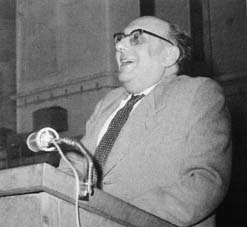
Before I go any further, just let this sink in for a moment. Jewish brothers….Nazi Germany….
It’s probably no surprise that digging up accurate information regarding the history of Wirgin is a bit difficult. Both the Wikipedia and Camerapedia articles are almost word for word the same. Most other sites that mention any part of their history usually recite facts from these same articles. Further complicating matters is that in 1938, the Wirgin brothers fled their home country due to increasing anti-Jewish harassment, and sold their entire business (another site says the factory was confiscated, not sold) to another German camera company called Adox, but bought it back after the war. I’ll do my best to combine all of the information I’ve found here, in the hopes that I get at least part of the history correct.
During my research into the history of Wirgin, I came across a couple of other German language sites with more information than what is available on either Wikipedia or Camerapedia. A particularly interesting one was a German language site by Leif Johansen. Since my only knowledge of the German language comes from playing Wolfenstein video games and watching Indiana Jones movies, I had to rely on Google’s translate feature to translate most of the site to English.
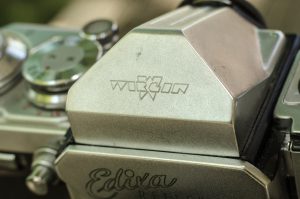
According to Johansen, in 1926 Wirgin released their first cameras which were a variety of 6.5 x 12 and 9 x 12 folding plate cameras sold under the names Gewir and Metadux. He then goes on to state that Wirgin would release a much smaller camera in 1927 that used motion picture 35mm film called the Edinex. Although I have found reference to this 1927 Wirgin on other sites, the more I dig into the company’s history, the more I doubt that this date is correct. I go into the specific history of the Edinex in greater detail in my review for the Wirgin Edinex II which you can read here.
In summary, Wirgin made some generally nice cameras, but lacked the prestige of the higher end German companies such as Leitz and Rollei. Their models were neither high or low end, and in some cases like the Wirgin Auta from 1935, incorporated features such as a self-erecting lens standard and top plate shutter release which was not common at the time.
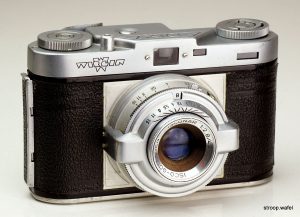
After World War II, the Wirgin brothers would return to Germany and reacquire the rights to their own company and resume making cameras. They would continue to offer some of their pre-war medium format and 35mm models, but by the 1950s, would devote their entire product line to 35mm viewfinder and rangefinder models such as the Edinex and Edixa. The Edinex series was aimed at the lower end of the market while the Edixa was more of a mid range rangefinder and view camera product line.
In 1948, Wirgin would hire a 24 year old man named Heinz Waaske who worked for them as a precision mechanic. Originally from Berlin, Heinz Waaske worked as a technician for Telefunken, which was a German radio company prior to the war. During the war, he fought in the German army and was taken prisoner by Allied forces. After the war, he continued to work with precision mechanics before being hired by Wirgin.
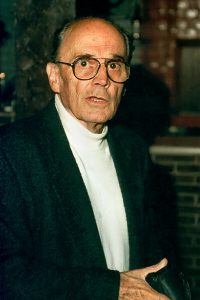
While working for Wirgin, he used his expertise and knowledge in precision manufacturing to improve upon Wirgin’s medium format cameras. He improved the reliability of various Wirgin models and allowed them to make them for less money. Eventually, he would rise to the rank of chief designer and would begin work on an all new 35mm single lens reflex camera. In the early 1950s, East Germany would dominate the SLR camera market since the Japanese camera market was still in it’s infancy, and only a couple Japanese SLRs existed at the time, so this was an opportunistic time for Wirgin to release an all new SLR with modern features and capture the market.
In 1954, Wirgin would release the Edixa Reflex SLR. The camera was originally to be called the Wirgin Komet, but due to a copyright infringement on the ‘Komet’ name, the camera was given the name ‘Edixa Reflex’, perhaps to build upon the reputation or sales of the Edixa brand. The new camera was designed primarily by Heinz Waaske and a team he hired consisting of former Praktica and Ihagee employees which meant the new Edixa shared some similarities to those two brands of camera. It combined the best characteristics of cameras from 3 different Dresden, East Germany camera makers. It would be a full system camera like the Ihagee Exakta, it would have the interchangeable M42 screw mount of the Praktica, and it would have an available pentaprism viewfinder like the Zeiss-Ikon Contax D. The Edixa was the first West German SLR to use the M42 lens mount and the first with a focal plane shutter. Until this time, West German camera technology was heavily based off Leitz rangefinders and their clones.
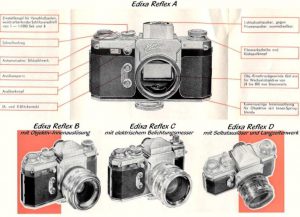
Although heavily inspired by the Exakta, the Wirgin Edixa much more closely resembled what we would now call a “modern” SLR. Unlike the Exakta which had the shutter release and wind knobs on the left side of the camera, the Edixa was designed from the very beginning to have the shutter release and wind lever on the right side where a photographer today would expect to find them. The body shape and size of the Edixa was also more consistent with modern cameras, losing the trapezoidal shape of the Exakta. Since Wirgin wisely chose the M42 “Praktica” lens mount, it meant that upon it’s release, there would already be a large selection of third party lenses available for a photographer to choose from. This is contrary to the Exakta’s proprietary mount which was not widely compatible with other German made cameras.
The Edixa Reflex-C being reviewed here was introduced sometime around 1957 and was in production until around 1960. It featured an uncoupled selenium cell light meter, full M and X flash synchronization, an internally linked automatic diaphragm, and a removable prism. It did not however, have an instant return mirror as that feature wouldn’t appear until the Edixa-Mat from 1960. Earlier catalogs show this same exact model as the Edixa Reflex II/B, and there exists a rebadged US import version known as the Astraflex 1000LM by Sterling-Howard of New York. I cannot find any information regarding production numbers, but it would seem that the Reflex C was a popular model in the late 1950s as it would have been one of the first to have a selenium cell light meter and an internally linked automatic diaphragm. Around the same time this model was being sold, there was another model known as the Edixa Reflex-D which was the same exact camera, except it had an expanded selection of slow shutter speeds all the way down to 9 seconds.
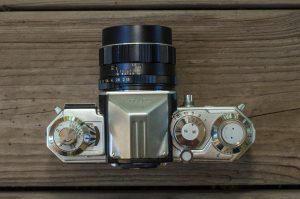
It is worth mentioning that although the Wirgin Edixa Reflex accepts any M42 screw mount lens, it’s threads are oriented about 5 or so degrees clockwise of other M42 screw mounts. This isn’t a problem for most M42 lenses unless you want to use lenses with the automatic diaphragm feature. Starting with the Edixa Reflex-B, the camera came with a moving lever inside of the lens mount which would press on a pin on lenses equipped with an Auto mode to keep the aperture wide open for composition. Then upon releasing the shutter, the lens would automatically stop down to the chosen aperture. In order for this feature to work properly, you would have to use an Edixa branded lens. I tried using an Asahi Super Takumar lens with the auto stop down feature and I can confirm it does not work correctly at all settings. You have to engage the aperture manually.
The Edixa series continued through the 1960s, consistently staying on the cutting edge of the 35mm SLR market. Wirgin would release the first internally triggered automatic diaphragm to automatically stop down a lens without the use of an external trigger at the same time as Praktica, and before any Japanese camera maker. The Edixa-Mat from 1960 introduced instant mirror return half a decade before Exakta or Praktica had it.
The Edixa line would continue to introduce subtle improvements to each new model, further refining and improving the camera until innovation suddenly slowed to a crawl in the early to mid 1960s. Future models would rarely have any improvements or new features. Even when some new features were introduced, like TTL metering, it was implemented poorly. By the mid 60s, the Edixa line was slow to incorporate features like a rewind crank and a fixed shutter speed selector. A short term switch to a new bayonet lens mount failed to be accepted by the market. Later Edixas would abandon the interchangeable viewfinder, settling on a more basic and less expensive fixed viewfinder. In 1965, Heinz Wasske would leave Wirgin and would work for Rollei where he would eventually design the Rollei 35, a very successful compact 35mm camera. In 1968, Henry Wirgin died, and the company became majority owned by it’s employees where the Wirgin name was completely dropped and referred to as Edixa.
By this point, the damage had been done, and the entire German camera market was in recession while the Japanese market was taking over the world. In 1970, Wirgin would struggle to remain profitable, and in 1971, would cease camera production altogether and go into bankruptcy. Unlike many other German marques that ceased production after the war, Wirgin was never absorbed into a larger company like many of the East German manufacturers. It would seem that East German manufacturers were all combined into a single entity by the Soviet controlled government, but for companies in West Germany, they simply would shut their doors for good.
Today, the Edixa series remains popular among collectors. Many of the cameras had unique designs that appeal to collectors. They were generally well built cameras, but due to their age, often suffer from the perils of time. Although there were some Wirgin branded lenses, many Edixas are found with any number of third party lenses such as those made by Schneider, Praktica, or Zeiss,
My Thoughts
As I’ve mentioned many times in other reviews, my budget for acquiring old cameras is generally quite low. I am not willing to pay the sometimes exorbitant prices people ask for vintage cameras, especially for those confirmed to be in good working condition. I had my eye on a couple of Edixas in the past but either their Buy it Now or closing prices were often way out of reach, so it took me some time to find one I was willing to take a chance on.

Earlier this year, I saw a listing for a body only Edixa that appeared to be complete. The seller who “didn’t know much about cameras” said that the shutter fired and that the body appeared to be in good condition, with the exception of the leatherette missing from the rear film compartment door. The missing leather and lack of a lens allowed the price to go quite below the asking price of most Edixas, so I took a chance on it.
Knowing that this one was a risk and the price I paid was low, I knew there was a good chance the camera could have more serious issues. When it arrived, I was pleased to see that the shutter did, in fact work. The fast speeds seemed to be fine, but once you went below 1/50, the second curtain would drag, and below 1/10, wouldn’t close at all. The curtains were in tact and had no obvious holes in them. The body was also in nice shape other than the missing leather which I already knew about. The viewfinder was pretty dirty, but was usable. The mirror seemed to work OK and didn’t exhibit any sticking issues that are common with older SLRs.

Edixas are gorgeous cameras by themselves, but they look even better with period correct all chrome barreled lenses, but since I didn’t have anything that looked the part, I attached one of my many Asahi Super Takumars to it. The good news is that the shutter worked properly at 1/100 and above, so at least the camera was partially usable. Holding the Edixa in my hand and admiring it’s looks, I think this is one of the best looking SLRs ever made. I used to think the Exakta was the most handsome camera in my collection, but I think the Edixa just oozes good looks. All of the knobs and dials on the top plate and the sides of the body have a deep shine to them. The metal that Wirgin used has not shown any signs of tarnish or oxidation. The edges of the film advance knob, the rewind knob, the frame counter, and the speed selector have deep knurls in them. They look tough, but elegant at the same time. I found myself on multiple occasions sitting there admiring the styling. This is one good looking camera.
I mulled about what to do with this camera as I generally do not have any luck with resolving shutter issues on SLRs. Should I just keep this as an outdoor only camera and only use the fast speeds? Should I attempt to buy some replacement leather and redo the body myself? I didn’t have these answers, so I put the camera on a shelf for a while.
Last fall, I picked up a Soviet made KMZ Start SLR in a lot of cameras on eBay. I wrote a full review of that camera which you can read here. This past December, I took that Start with me on a trip to Michigan for it’s inaugural roll. but after seeing the results of that first roll, I knew something was wrong with the camera. Part of the problem ended up being due a poor choice of film, so I knew that I had to shelve that camera and revisit it at sometime in the future.
That time came in early June when I was talking to my friend Adam who runs another vintage camera review blog like mine. If you’re interested, check out his Quirky Guy with a Camera blog here. One thing Adam frequently does when testing out new cameras is to take a roll of film and shoot a couple of frames, then remove that roll in a dark room, and put it in another camera and shoot a few more frames. That way, he only devotes a small portion of a whole roll to a camera that he is unsure of. If the camera turns out to be a dud, he only wasted a couple of frames instead of a whole roll.
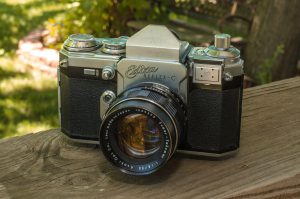
After talking to him, I realized that this was a perfect opportunity to test out both the KMZ Start, and this Wirgin Edixa. The flaw in my selection of film for the Start was that I used heavily expired film which I was unfamiliar with. So this time, I chose a fresh roll of FujiColor 200 film. I loaded that roll into the Start and fired off 12 shots in my backyard of my son playing, some flowers, and a few other things. At the halfway point in the roll, I put the whole camera into a film changing bag with the Edixa, pulled the half finished roll out and installed it into the Edixa so I could shoot the remaining 12 frames. Yes, I am aware that the KMZ Start has a film cutting blade for this very purpose, but cutting the film would have required that I put it into it’s own reloadable cartridge, which I did not have, but also, since I do not do my own developing, I would have had to send in both halves of the roll paying double to get them developed as two 12 exposure rolls each.
Even though I didn’t start out with this thought, I realized that this was a perfect opportunity to do an apples to apples comparison of two cameras that have quite a bit in common, using the same exact film, and shooting the same exact subjects.
Before I go on, you might ask yourself how similar are the Edixa and Start? They’re both 1950s designed SLR cameras aimed at the mid to professional market. They both took cues from the Ihagee Exakta with interchangeable lenses and viewfinders, a split image rangefinder prism viewfinder, cloth focal plane shutters, are capable of all of the same shutter speeds, both have front shutter release buttons, and both lack an instant return mirror. While it might be a bit of a stretch to compare the Helios 44 lens of the KMZ to the Asahi Super Takumar that I had mounted to the Edixa, both are highly regarded standard prime lenses.
So, after getting the roll loaded into the Edixa, I fired off 12 more shots until I reached the end of the roll and sent it into the lab. Knowing that the Edixa could have focal plane issues, light leaks, or some other shutter issue, I figured this one roll would help me decide the fate of two questionable cameras.
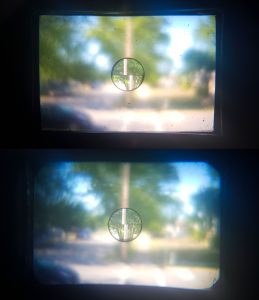
While shooting with the Edixa, I could immediately see that this was a much more pleasant camera to shoot with than the KMZ Start. I won’t go too much into my issues with the Start, but the Edixa had a much easier to use front shutter release. Depressing the shutter release button was very smooth and required little effort. The viewfinder was very bright, and although dirty, was very easy to see through. I will say that the Edixa has the brightest viewfinder on any camera I’ve used made before the late 1970s. The split image rangefinder in the center of the viewfinder was very clear and allowed me to accurately focus all of my shots, even those shot indoors.
The lever wind was comfortable and allowed for easy advancement of the film while keeping the camera at eye level. I shot with the camera at 1/100 for most of the roll, but tried 1/50 a couple of times, and found that changing shutter speeds was uneventful. Like the Soviet camera, changing the shutter speed requires lifting of the shutter speed dial rotating it to your desired speed, and then letting it fall back into place. Per the Edixa’s user manual, and unlike the Soviet cameras, you are free to change the shutter speeds on the Edixa regardless if the shutter is cocked or not.
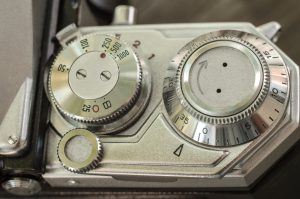
The shutter speed dial shows shutter speeds from 1/25 – 1/1000 and a setting for B or ‘Bulb’ mode. Next to the 1/25 shutter speed is a red letter ‘O’ which is used for shutter speeds slower than 1/25. In front of the shutter speed dial is a sliding lever that has additional shutter speeds from 1 second to 1/10. In order to use these speeds, the shutter speed dial must be moved to the ‘O’ position, and then you can slide this lever to 10, 5, 2, or 1 each representing 1/10, 1/5, 1/2, and 1 second respectively. While a bit clunky, it was very common in the 1950s for cameras to have separate fast and slow shutter speed selectors. Even the Ihagee Exakta, to which this camera was likely marketed against has separate speed controls.
Next to the speed selector is a large and simple frame counter showing numbers from 0 – 36. Like modern cameras, the frame counter counts upward, so after loading in a new roll of film, you must manually set the frame counter to ‘1’.
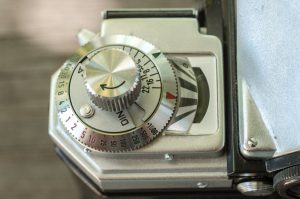
On the left side of the camera is a film reminder dial, the rewind knob, and the meter. The meter is unique to the Edixa Reflex-C, but was non functioning on my example. No amount of light would make the needle move, so I completely disregarded it while using the camera.
On the front of the camera beside the shutter release button is a sliding switch that locks the shutter release from being depressed. This could be useful if you wanted to cock the shutter to have it ready for the next frame, but still put the camera in a bag without the risk of the shutter being accidentally tripped. Below the front shutter release are the two PC ports for M and X flash sync.
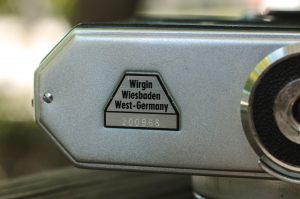
On the bottom plate of the camera is a small plate that reads “Wirgin Wiesbaden West-Germay” followed by the serial number. Next to it is one of the few design elements of the Edixa which I do not care for, which is a protruding tripod mount. The tripod mount sticks out about a quarter of an inch and interferes with the camera from sitting level on a flat surface. If you are careful, you can balance the camera on it’s tripod socket, but the camera will be wobbly. This would negatively impact your ability to take extended shutter speeds on a table without the use of a tripod. Finally, to the right of the tripod socket is the rewind button for when you reach the end of the roll.
Although I had to load film into the camera in a dark bag, loading film into the Edixa is easy to do. The design of the film compartment is like most modern cameras with one exception which is that the rear door swings open to the left instead of the right. This means that the side of the camera where the take up spool is opposite of the door hinge. This could possibly allow light to leak into the film compartment on the take up side. Otherwise, loading film is a normal left to right process. The take up spool has only one slit, but it was easy for me to feed the film in and advance it until it was tight. Closing the door is uneventful as it has an external sliding latch like most cameras of the era.
Shooting with the Edixa was quite pleasant, and as I mentioned earlier, had a very modern feel to it. While the camera is solidly built, it is no more heavy than a 60s or 70s Nikon SLR. The camera feels robust and purposeful in your hands. There are no croaks or groans while handling it. The advance lever moves purposefully and does not wobble. I won’t say much about the lens since I was using an Asahi Super-Takumar M42 lens, but the pairing worked really well. The Takumar’s smoothness of operation made it feel like it was meant for this camera. I mentioned earlier in this article that the Edixa’s lens mount is oriented about 5 degrees clockwise of a standard M42 mount, so the automatic diaphragm feature of the camera didn’t quite work correctly with the Takumar lens, but I found that by setting the Auto/Manual switch of the Takumar in Auto mode helped me compose my images with the lens wide open, set my aperture, then with a flick of my left index finger, I could put it back into Manual mode to stop down the lens. While not as elegant as if I had a genuine Edixa branded lens, it worked quite well and didn’t seem disruptive.
Overall, I enjoyed shooting with the Edixa a lot more than I thought I would. My excitement level rose while shooting with it, but how would the images turn out? This whole experiment of using one roll of film split between two questionable cameras was designed to lessen the cost of ruined film. Surely the positive experience I had while shooting with it, would turn out at least serviceable results, right?
My Results
Two thoughts came to mind when I first saw the results from this roll.
- Holy crap, these look great!
- Wow!
Simply, I could not be happier. These are some of the sharpest and most colorful 35mm shots I’ve taken with any old camera. To think that I shot all 12 frames in the Edixa over the course of maybe 30 minutes using stuff around my house really makes me wonder what this camera could have done if I had spent more time with it.
As excited as I was, I had to remind myself that the camera can’t get all the credit. I was using one of the best lenses ever made. I think what still impressed me so much was that the camera was able to make the most of what the Super Takumar could offer. One of the above shots of the birdhouse was shot with a 135mm Super Takumar which I shot at 1/200 with the camera stabilized on a picnic table and even that came out great, but otherwise the rest were all done with a 55mm f/1.8 Super Takumar.
There was one shot that had a noticeable light leak and the two of the railroad crossing signs are a tad more exposed on the right side of the frame which could indicate another leak. None of this surprises me considering I made no effort to seal up the film compartment from leaks. I can’t explain why the light leaks are not present on other shots. Maybe right after or before those shots, I happened to let the camera sit too long exposed to direct sunlight. It was pretty sunny that day, after all.

Comparing the results from the Edixa to those shot with the KMZ Start, there is no comparison. To be fair, the Start clearly has some mechanical issues that impacted the focus. It’s Helios lens should be capable of better results, but if you do an A/B comparison of the shot of the sidewalk chalk, you can really see the huge difference between the Edixa and the Start.
I guess I owe Adam a bit of gratitude. While his idea of using the same roll of film in two cameras is certainly something others have done before, without talking to him about it, I don’t know that I would have thought to do it myself. I probably would have waited longer to test out the KMZ Start and possibly even longer to get to this Edixa. It probably would have languished in “the queue” for quite a while, but now that I have this split roll back, it definitely excites me more for the future of this camera.
In addition to the quality of the photographs, the experience while shooting with this camera was superb, and I can’t say enough about how good looking this camera is. While we can all appreciate the performance and craftsmanship of a Nikon F or a Minolta SRT SLR, they’re pretty boring looking cameras. The Edixa is both a beauty queen and a capable athlete rolled into one.
I think I will order some replacement leatherette and redo the entire body. Although the front looks good, I don’t have the piece for the back and I want to make it match. I’ll have to look into sealing up the film compartment better to prevent light leaks, but I am not sure if I want to attempt to resolve the slow speed issue. It’s possible that some Ronsonol under a top plate might resolve it, but I don’t have nearly the luck with SLRs as I do older, and more basic, folding cameras. Since this particular Edixa performed so well at 1/100 and higher, I might just leave it as an outdoors only camera, which is fine because I shoot most of my film outdoors anyway. It certainly produces nice shots and I have more than enough M42 lenses to go around.
I cannot wait to shoot with this camera again.
Related Posts You Might Enjoy
External Links
http://camerapedia.wikia.com/wiki/Wirgin_Edixa_series_(SLR_models)
http://www.ukcamera.com/classic_cameras/wirgin2.htm
http://www.kl-riess.dk/gewir.html
http://www.collection-appareils.fr/x/html/appareil-1514-Wirgin_Edixa-Mat%20Reflex%20mod.%20C.html

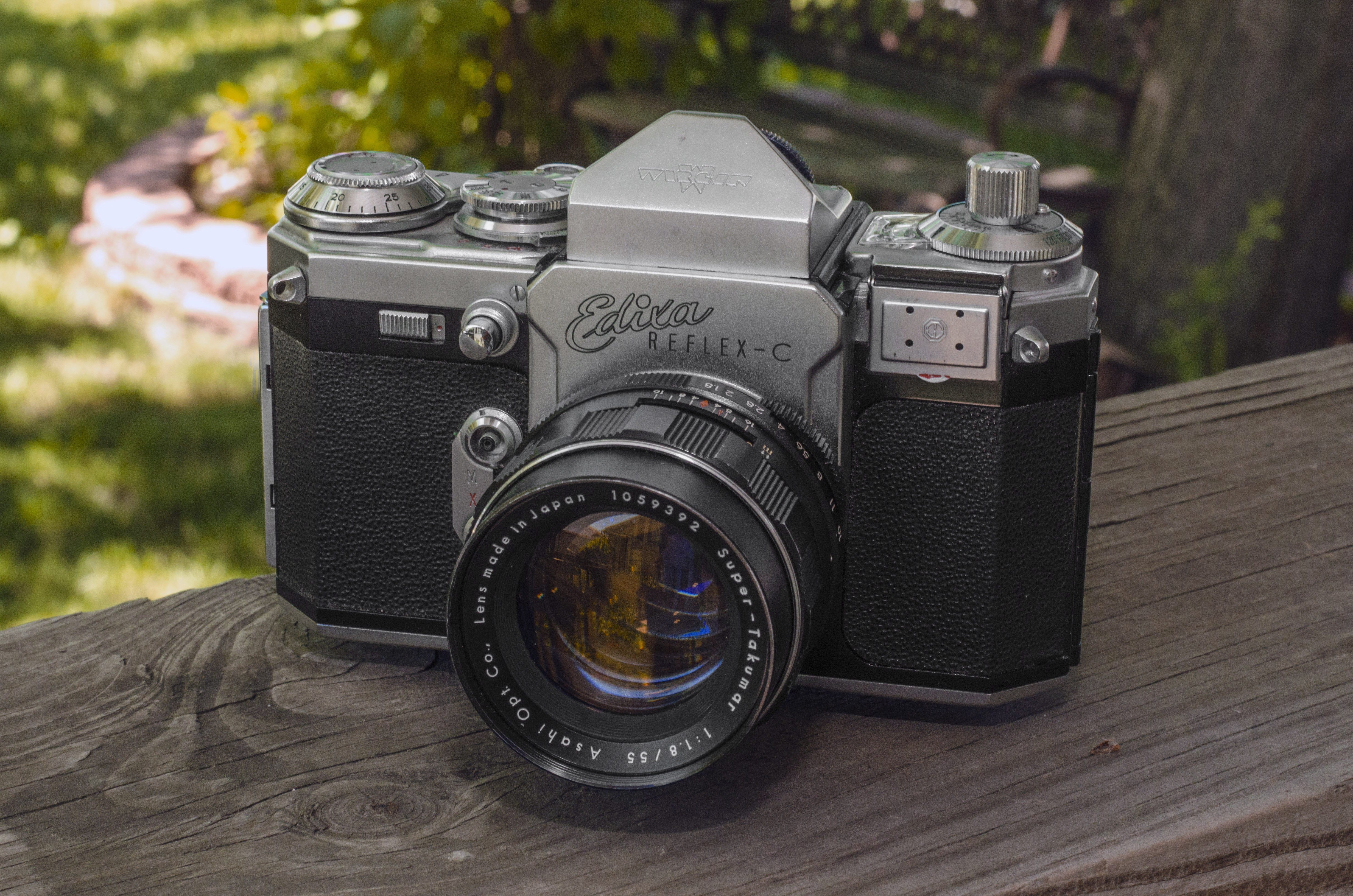
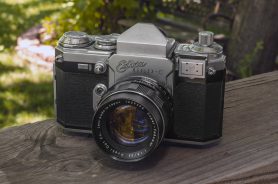
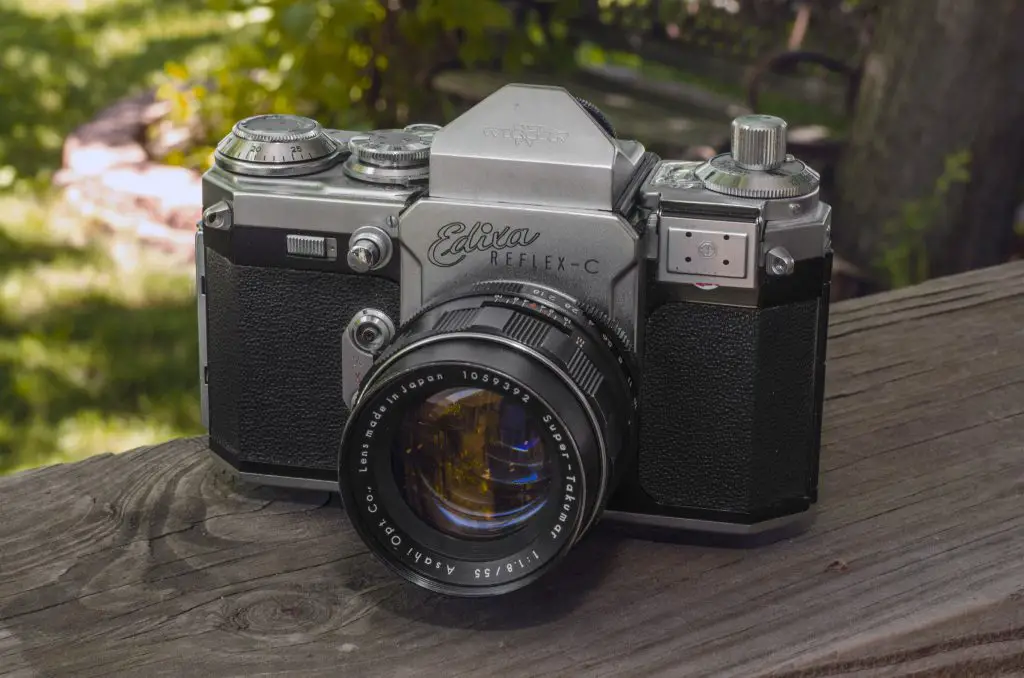








Super interesting review!
Bought an Edixa Reflex-C just over a year ago and was also blown away!
If you still have the camera and want to fix the shutter problem there’s the possibility to ship it to one of the old Wirgin factory workers in Germany who today provide for himself through servicing these old beauties. Using only original tools and parts!
Also, you really ought to get your hands on an original Edixa lens. Mine are a little slow, but they’re the only lens i’ve used so far that gets the camera to it’s full potential!
Once again, thanks for a nice review!
Thanks for the feedback, Antoine! I would love to be able to send mine over to Germany to have it repaired by an original factory technician, but it would be prohibitively expensive for me. Not to mention, I have probably another 30 or more camneras that could also benefit from a full servicing, so I have to be discriminate on which cameras I spend money on.
Interestingly, since posting this article, I have located a genuine Edixa lens. It is an Isco-Gottingen Edixa Westanar 50/2.8 lens. Cosmetically, it is in good shape, but there is oil on the blades, so the iris is sluggish when stopping down. I have not had a chance to shoot with the lens yet, however, but once I do, I’ll be sure to update this review!
Mike, I have in my possession an Edixa Reflex-C, which I have had for about 25 years. I found it in an old shop in Australia, where I live. It comes with an Edixa-Traverna lens 1:2.8/50. There are other lenses in the square leather carry case, but they are Japanese. The serial number underneath reads 205250. I have used this camera and found it to be excellent, particularly for long range shots, the clarity was great. I have no idea of what this is worth as I though maybe a collector would be interested. On reading your article I thought you may be able to advise me. Regards Steve Quarrell.
Hi Steve, as you know those Wirgins are quite nice cameras. Since writing this article, I’ve come across two more one of which is in perfect working condition. Their value is all over the place though. Like most cameras, the lens attached is where the big money is. The 50/2.8 lenses usually have a pretty low value, even though they are still good performers. My advice is to keep using it and have fun with it and don’t bother trying to sell it as you’ll likely be disappointed in what you’d get from it.
Great review! I love the Edixa Reflexes, and have most of the models, up to the Edixa Prismat in Ringfoto rallye guise from 1970. They don’t all work perfectly, but are all true beauties, and operate.”as smooth as silk”. I have at least temporarily freed up the slow shutter speeds, by spraying Electrical Contact Cleaner in and around the speed dials, and working them a bit ( may take several sprays, and won’t hurt the inner workings) It seems to reactivate gummed up lubricants. Good luck, with your beauties! Thanks